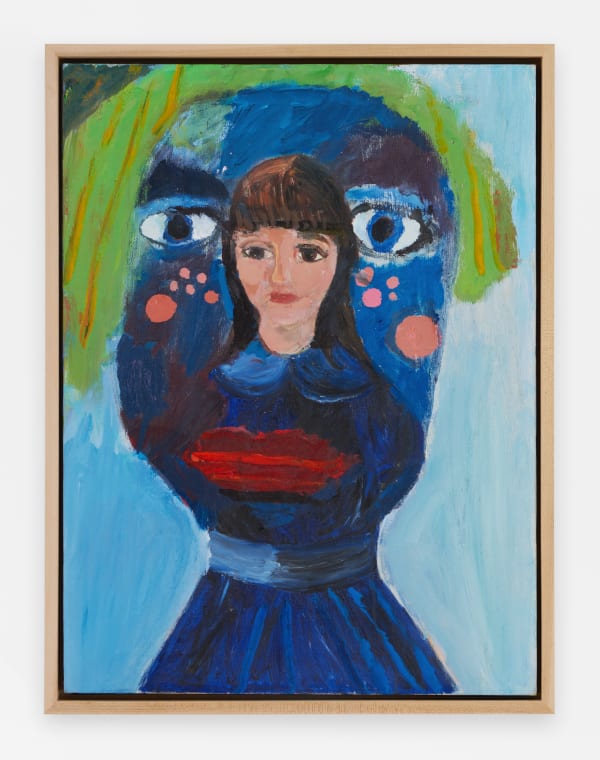Margot Bergman
Anton Kern Gallery is pleased to present Margot Bergman’s third solo exhibition at the gallery, now bringing focus to the artist’s collaborative paintings created between the mid-1990s and 2010. During this pivotal period of her practice, Bergman appropriated paintings that she discovered in Chicago thrift shops, and overpainted the strangers’ works to create uncanny portraits. In hindsight, both the artist and viewer can recognize this series as an important bridge to her portraits of women, which have become the mainstay of her practice in recent years.
When encountering amateur paintings in a thrift shop, Bergman empathized with their creators; how they would have felt to see their work abandoned in a jumble and cheaply priced. After rescuing the works and enjoying their company for a time in her studio, the artist came to recognize that there was something contained in each one, waiting for her. A new creative impulse was unlocked. Where the former author’s work ended, Bergman’s began.
As is evident across the eighteen small-scale collaborative works on view, Bergman’s level of intervention varies from canvas to canvas. In some cases she leaves the majority of the original work unaltered, while in others only a small area is still visible. Utilizing her exacting visual prowess, she repurposes representational objects within a landscape or still life, turning them into facial features. She deftly makes use of negative space too. Eyes emerge from flowers and a boat becomes a smile. Animals become humans, and humans gain an alter ego with a second face engulfing their own.
In Ginger Al, for example, a rendered three quarter view of a woman’s face becomes the center of a double portrait, with Bergman’s thickly-applied fleshy paint surrounding it with an additional pair of eyes, bright red lips, and cascades of orange hair. In addition to overpainting faces, the artist would find herself repeatedly masking out the shape of a rabbit. In examples such as Peony and Chucky, the outline of a rabbit crouched on its hind legs creates a window into the underlying composition, a floral still life, and a scene of a mother and son at the park, curiously shifting the foreground and background.
For over six decades, Bergman has operated as an independent force within the Chicago scene, working rigorously with limited feedback from the outside world. This insulation brought her focus to the interior, and enabled her to hone a sophisticated and peerless style. In the freedom of Bergman’s compositions, one can sense a spiritual affinity with the breakaway 20th Century European art movement COBRA, or Art Brut. Her works possess raw unadulterated vitality, and an embrace of pre-conscious or unconscious instinct. Bergman’s painting process, automatically finding faces where there are none, is strange even to herself. Seen together, these psychologically stirring paintings are an expression of the lifelong search to understand the actors within her own psyche that shapes her experience of the world.
-
 Margot BergmanFarmer's Daughter, n.d.
Margot BergmanFarmer's Daughter, n.d. -
 Margot BergmanDaisy, 2003
Margot BergmanDaisy, 2003 -
 Margot BergmanRosalee, n.d.
Margot BergmanRosalee, n.d. -
 Margot BergmanYukon Goldie, n.d.
Margot BergmanYukon Goldie, n.d.
-
 Margot BergmanGrace, 2001
Margot BergmanGrace, 2001 -
 Margot BergmanGinger Al, 2012
Margot BergmanGinger Al, 2012 -
 Margot BergmanBilly Joe, 2008
Margot BergmanBilly Joe, 2008 -
 Margot BergmanGreen Goddess, 2007
Margot BergmanGreen Goddess, 2007
-
 Margot BergmanGena, 2001
Margot BergmanGena, 2001 -
 Margot BergmanElizabeth Jane Veronica McMillan, 2010
Margot BergmanElizabeth Jane Veronica McMillan, 2010 -
 Margot BergmanKitty, 2011
Margot BergmanKitty, 2011 -
 Margot BergmanPeony, 2008
Margot BergmanPeony, 2008



























